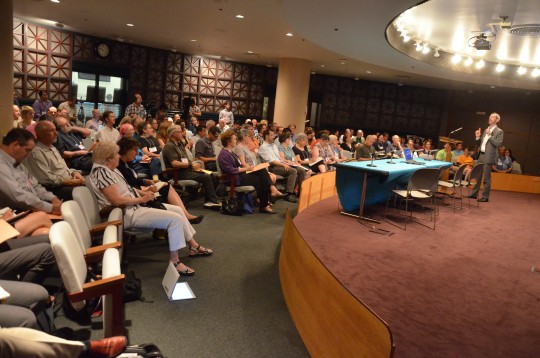
(Photos: M.Andersen/BikePortland)
“Our cities have minimum bedroom requirements for cars but not minimum housing requirements for people.”
— Jeffrey Tumlin
If anyone needed evidence that parking policy matters to Portlanders, it arrived at the Portland Building Monday in the form of 130 people, many armed with pen and paper, to attend a five-hour “symposium” on the subject.
The event organized by the Portland Bureau of Transportation drew a who’s-who of neighborhood association and city transportation officials. One was Transportation Commissioner Steve Novick, who said that parking was the transportation issue he hears about more than any other.
The keynote speaker, Nelson\Nygaard parking consultant Jeffrey Tumlin, presented a 16-point parking strategy that revolved around a single concept: parking is too expensive and too valuable for us to conceal its costs inside the price of everything else we buy.
The key, Tumlin said, is to recognize that the cost of building and maintaining every parking space at the mall is already a burden on the public: it’s built into the price of every shirt that’s on sale inside.
“It’s not that the parking is actually free, it’s that instead of having the motorist pay for it, we’re having everybody pay for it,” he said. “You may only have 15 percent of the population without a car, but those 15 percent are subsidizing the parking for everyone else.”
The same is true in the housing market, Tumlin said. In his hometown of San Francisco, he said, each on-site residential parking space in a new apartment building drives up the cost of the room by 15 to 30 percent and decreases the space for actual human housing by 15 to 25 percent.
“Our cities have minimum bedroom requirements for cars but not minimum housing requirements for people,” he marveled.
Tumlin said that because wealthier people are so much likelier to own cars, San Francisco has found that zero-parking apartments are less susceptible to rent spikes.
“Yuppies will invade every neighborhood as long as there is a place to park their SUVs,” he said.
Another problem of free parking: traffic congestion. Tumlin said 15 percent or more of traffic on commercial streets is “not traffic that’s going anywhere, it’s just people circling around looking for a place to park.”
This is especially costly, Tumlin said, because parking requires so many turns, which clog roads especially fast. This graphic shows a hypothetical person’s trips around a neighborhood that manages its parking by providing enough space for everyone to park for free. The P markings are parking spots and the T markings are turns:
Tumlin contrasted this with “park-once” neighborhoods, which he said make it possible to park but keep everything close enough that people walk in between their destinations:
These problems with parking have some interesting implications, Tumlin said.
“Too much parking can be even worse than too little,” Tumlin told the crowd. “Instead of talking about how many new parking spaces we need, we should talk about how we can manage those new spaces and, even more importantly, how to manage the resources we already have.”
Advertisement
The road to good management, he suggested, starts with charging for parking in high-demand neighborhoods.
“The correct price of parking is the lowest price where there is almost always one or two parking spaces available in a given parking lot or block,” he said. “This is also the correct way to set the price of every other product. This is how Southwest Airlines sells plane tickets.”
Cities often feel pressure to build more off-street parking lots, he said. But he warned that this is futile without also either pricing or regulating on-street parking.
“Creating more unused off-street parking spaces will not free up on-street spaces,” he said. “Only managing your on-street parking will do that.”
Also, he said, because parking garages cost about $30,000 per space to build, “it will always be cheaper to use technology to help motorists locate the spaces that are currently available.”
Another interesting note in Tumlin’s argument: residential programs that offer free or low-cost parking passes only to residents of the neighborhood may be unfair, but he said they’re a tradeoff worth making in order to institute paid parking in fast-changing commercial areas nearby.
“Warning: residential parking permits are anti-market and anti-democratic,” he said.
What does this all mean for people who care about biking? Though bike lane believers are accustomed to battles over removing parking, Tumlin’s prescription for good parking policy really isn’t about making it easier to take parking spaces off the street. Instead, it’s mostly about changing something even more fundamental to a city than its streets: its buildings.
A city where parking is plentiful, Tumlin said, is familiar, because most neighborhoods built after 1950 (when U.S. cities started requiring off-street parking) look so similar:
This isn’t, needless to say, the sort of neighborhood where many people will choose to ride a bicycle or (even worse) walk or use public transit. The point of parking reform isn’t to improve biking tomorrow; it’s to prevent a city from gradually transforming into the picture above.
“Your regulations are about the city you want 40 years from now,” Tumlin said.
— Learn more about PBOT’s work at their Central City Parking Strategy webpage.


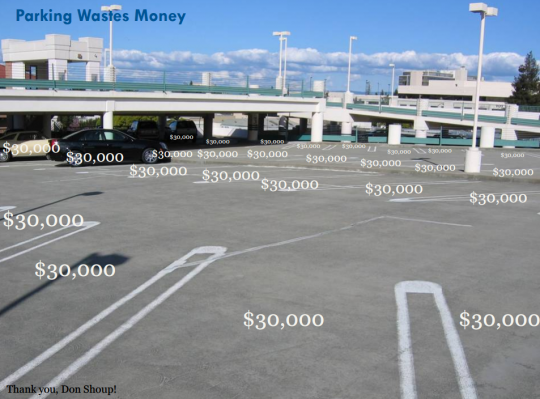

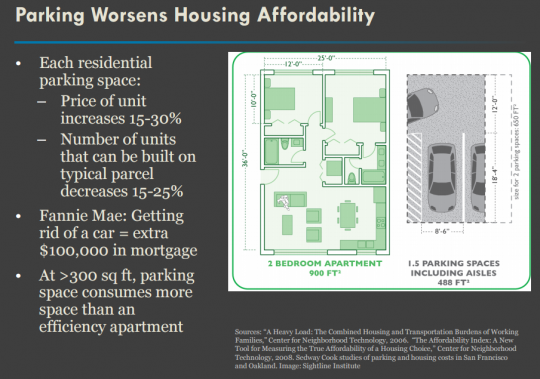



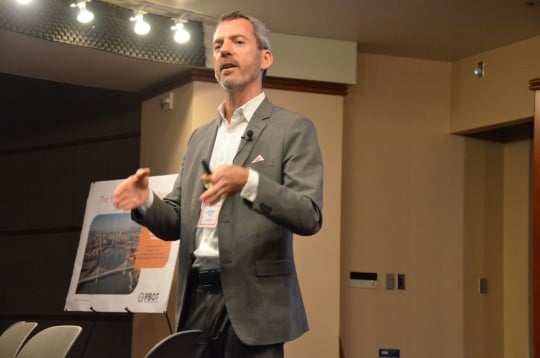
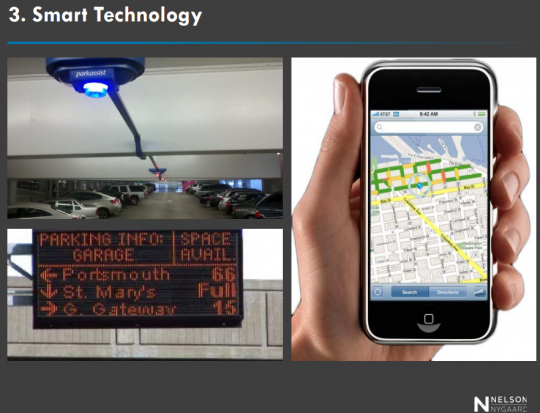
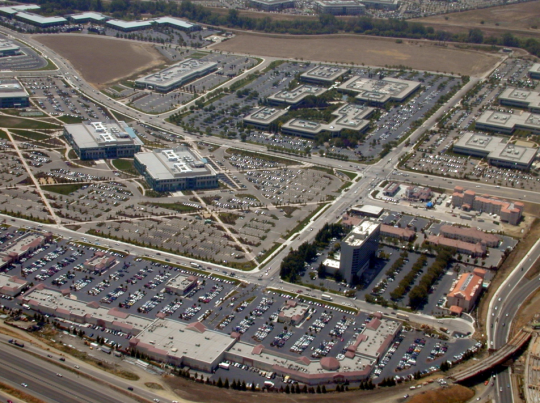
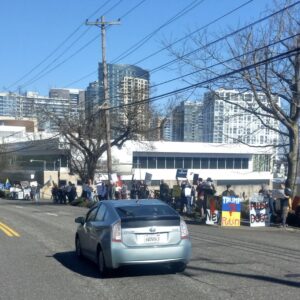


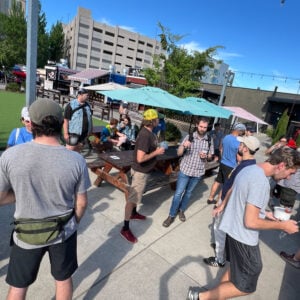
Thanks for reading.
BikePortland has served this community with independent community journalism since 2005. We rely on subscriptions from readers like you to survive. Your financial support is vital in keeping this valuable resource alive and well.
Please subscribe today to strengthen and expand our work.
Bike valet takes up 20 times less space then a car parking lot. If you build it they will come!
And, NO noxious emissions by bicycling clientele!
Nice.
Visions of Donald Shoup danced in his head….
If people have to pay for parking, they might not make that car trip. That means less auto traffic in that commercial district and a better place to walk and bike. Perhaps they’ll walk to someplace closer, take transit or bike. That sounds like a win-win for the biking community.
There’s paid parking all over downtown, and given that nearly every parking spot I see is full, I wouldn’t say it acts as a deterrent to auto use. Of course, there would be some price point at which people with less money start to get priced out, and parking would become easier for those with more, perhaps attracting some drivers who currently avoid downtown because parking is a challenge.
That just means the rate is too low.
From an economics point-of-view, I totally agree — if the spots are fully booked, the price is too low. All I’m saying is that raising the price too far will have a differential effect on the rich and poor. Maybe that’s fine, but given the frequent recurrence of the equity thread, I thought it worth mentioning.
You’re assuming everyone has to drive downtown. All MAX lines and many bus lines go downtown. If too mane people are driving that could be taking public transport, that just means it’s too easy and cheap to drive.
Or, perhaps public transit is too expensive and inconvenient. Or, possibly a combination of the two.
There’s always the bike option, you know. Many people reputedly take that (free) option.
it’s not necessarily ‘free’. It might take me longer and prevent me from trip chaining.
“it’s not necessarily ‘free’. It might take me longer and prevent me from trip chaining.”
Can you elaborate?
I’m having a really hard time grasping how this is not a free option. No gas, no parking costs, no costs for infrastructure maintenance shoved onto others from the wear and tear your vehicle exacts on the roads, etc. What is not to like?
Time. That’s what he is getting at. Many trips will take longer on a bike, so having extra time available is important for some (many) people.
I got that. There’s a bit of this conversation that got shunted to the very bottom of the page.
But it can also run the other way. The (chained) errands I run often (I imagine) can be accomplished more quickly on a bike than if I were in a car. Parking is basically never an issue; I don’t get stuck behind long lines of cars; my routes are sometimes more direct; etc.
Sometimes the convenience (or speed) of the car is overrated.
I’m assuming some people have to drive downtown. I’m also assuming some of those who have to drive are also poor. I’m further assuming that a price increase will hurt them more than someone with more money.
Which, as I said, may be fine — it’s a value judgement balancing many factors, and trying to find the optimal policy.
Except that in other places when the price of something our government regulates goes up (e.g., parking) the extra funds can and typically are used to offset the burden these charges represent. It seems unfair and unhelpful to only focus on the costs here and skip over the possibility that we could plow the funds back into a better system for everyone.
Are you seriously proposing using proceeds from increased parking costs to subsidize people parking?
Of course not. The funds would/could be used to shore up alternatives that don’t require expensive parking solutions (free bus service, bike infrastructure, and the list goes on).
I’m assuming that those that HAVE to drive downtown do it because they need their vehicle for work, thus their employer pays for parking…
if an employer requires you drive and doesn’t make space for it at their cost then they’re just evil…
or it could be just right.
Or the transit rate is too high. It would cost me $6.50 to take transit to work in the Lloyd Dist. and only $6 to park all day. How does that pencil? To get 2 people to an event downtown by transit would cost $13 (3.25/trip/each way) and we all know you can park for way less than that.
You can get an all day pass for only $5. And is that $6 including your gas?
it was a deterrent to me… after dealing with circling for parking for a couple years after moving here I stopped driving into downtown and took Fareless Square into town…
once they removed Fareless Square I had already converted to low-car use, but if I hadn’t then I would have went back to driving and circling for parking…
I say we tax driving to the point that we can make public transit free…
Requiring parking in new developments near frequent transit is the most shameful thing the Hales administration has done. What a waste. On a side note, I’m traveling in Silicon Valley for business and I spent 20 minutes trying to drive to a grocery store less than a half mile away. I tried driving because it’s a six-lane arterial and there are no sidewalks. I miss Portland!
where did Hales require that?
In 2013 the City Council amended the Zoning Code to require minimum parking ratios in many locations that didn’t previously require them. It was early in Hales’ term as mayor.
He’s publicly admitted that it wasn’t particularly great policy making, but that the council saw it as the least they could do. It was a hot topic three years ago, and it no longer seems to be much of an issue. So to that extent, it worked.
Why should it matter if you are near transit? I’ve seen little evidence that people who can afford one of the new apartments on, say, Division are any less likely to own a car than those who rent a comparable apartment more than 500′ away from Division (but a similar distance from Downtown). Why should one developer be required to provide parking but another one not?
The policy was designed to discourage auto ownership by creating less expensive housing (because of no parking requirement) near transit (where people presumably wouldn’t need a car). Instead, a large proportion of the tenants continued to own cars, the neighbors who bore the brunt were very angry and vocal, and instead of lowering the rent, the developers pocketed the extra profits.
The policy failed. It should have been repealed.
the policy didn’t fail, neighbors just complained about having to share…
The policy didn’t achieve its goals. It failed.
“Yuppies will invade every neighborhood as long as there is a place to park their SUVs,” he said.
This is the most persuasive argument I’ve seen yet for low-parking development.
Dang complicated.
A lot of what Tumlin says seems wrong to me. I’ll take one example:
“You may only have 15 percent of the population without a car, but those 15 percent are subsidizing the parking for everyone else.”
A majority of those without cars (60% according to a relatively recent Brookings Institution study) are people who have an income at or below the poverty line. They don’t subsidize the cost of parking for anybody because they are not a net contributor to state/federal income (e.g. they get more in benefits than they pay in taxes… generally speaking people living below the poverty line (thankfully) don’t have any tax burden). So indeed it’s not 15% of people without a car who subsidize everyone else, it’s a smaller percentage than that. Furthermore, he says that 15% of people don’t have a car, but the “equity issues” slide says 7.8% of “American residents” (which I assume is another way of saying people) don’t have access to automobiles. Which is it.
There are other numbers that seem equally fishy (I have sincere doubts that Portlanders spend 15% of their time on the road circling looking for parking. It’s REALLY easy to find parking in Portland). This has aan “85% of statistics are totally made up” sort of vibe to it.
Every time you buy something from a store that has parking, you are subsidizing parking. Last I checked the poor buy things from the store just like everyone else.
Yes. And, while the equity issues are important, I think a focus on poor non-users is misplaced because many would become users given a bit more money. Thanks to socialized automobiling, non-users are subsidizing users, but everybody is paying for it with hidden fees and passing a massive debt on to our kids. Most people don’t even question whether they should drive to the mall and buy some junk. But if they did, they may just decide “I’m paying for it either way, might as well enjoy it”.
Move *all* of the costs into fuel and cash-only tolls and many more people would be biking around with some nickels in their pocket (I prefer the belt-mounted dispenser, but you don’t need special gear to ride a bike.)
Parking costs bearing more heavily on the poor is a very similar effect to sales tax bearing more heavily on the poor. http://www.citylab.com/work/2015/01/how-local-sales-taxes-target-the-poor-and-widen-the-income-gap/384643/ seems like a pretty good discussion of that effect.
For a variety of reasons, poor people not only tend to spend a larger percentage of their income on things that come from places with parking lots, they’re also more likely to buy things in physical stores (vs. online) than wealthier individuals: http://www.businessinsider.com/the-surprising-demographics-of-who-shops-online-and-on-mobile-2014-6
So if you’re poor here’s what you’ve got going for you:
1. You can’t afford to get a fuel-efficient, reliable automobile to get to your job/childcare/probation appointment/etc/etc. so you need to spend more in absolute terms on gas/repairs than someone wealthier. (In relative terms, of course, you really lose out on the transportation category.) We’ll skip further discussion of the impact on your career/child custody/ability to stay out of prison of your old car breaking down for now.
2. You can’t afford to live in one of the nicer neighborhoods where you could maybe do without a car.
3. Public transportation does not reliably and quickly get you to your job/childcare/probation appointment/etc/etc. because wealthy people keep voting against public transportation funding (they buy stuff online/have a nice car that they enjoy sitting in/work downtown in an office building that’s already well supported by public transit/rode a bus once and there was a smelly/teenage/different colored/non-English speaking person on there and ugh/saw on Fox that a person got robbed on the train once and therefore it’s conclusively true that the train is 24/7 robberies) and/or the city is huge so there can be parking lots around everything.
4. You are likelier to live near the freeway or other major source of air pollution.
5. You can’t bike to your job/childcare/probation appointment/etc/etc because it is too far away (because parking lots), there is no safe bike route between here and there (because you live near the freeway/city hall hasn’t gotten around to putting facilities that far out yet/wealthy people don’t vote for bike infrastructure (see above re: public transit)/etc), your bike got stolen recently (because meth/wealthy people don’t complain to the mayor about bike theft/you couldn’t afford a fancy lock because you just had to buy another new used bike/etc), you’d get fired if you arrived at work sweaty and there is no facility for you to shower after arrival, etc.
6. You can’t afford internet or a computer/don’t know how to buy stuff online.
7. So you’re driving or getting a ride everywhere, shopping at places that cater to people with a car (because you are shopping at the cheapest place possible and the cheapest places possible know that their customers are in cars because of all of the above) and buying cheap processed ready-to-eat food (you don’t have time to cook thanks to all this time spent driving around/working two minimum wage jobs/etc.) or low quality products that won’t last long (you can’t afford the medium quality stuff that will work well and last longer). Now you’re overweight from eating terrible food and throwing out a bunch of broken stuff (which increases the need for trucks to deliver replacements/take away the trash, which increases congestion, which increases the time you spend in your car, etc.).
8. Now you’re sick because you live next to the freeway/eat bad food/get no exercise/don’t have time or insurance for preventative care. You’re uninsured because you had to choose between health insurance or transportation, so you head to the ER. (Urgent care is allowed to turn you away if you are uninsured so you don’t even bother trying to go there even though you are aware it is cheaper.) The ER takes you to collections when you can’t pay and your wages get garnished and you can’t afford to make your car payment anymore so your car gets repossessed and you get fired/lose custody/get sent back to prison.
9. Now meth sounds like a good idea because it’s not like anything else going on in your life is making you feel good right now.
10. You steal your neighbor’s bike to buy meth…
¡Viva la revolución! (May have wandered a bit there, but the point is that all this stuff is connected, and yes parking policy matters because better cities matter because poor people matter because a just world is a world where you would be equally willing for your child to be born to any parents anywhere in the world.)
This is a compelling picture, Brian, and I personally agree with the gist of it. But this claim in (7) is new to me:
You’re shopping at places that cater to people with a car (because you are shopping at the cheapest place possible and the cheapest places possible know that their customers are in cars because of all of the above)
I didn’t see any evidence in either of your links that people in poverty or with low income are more likely to own a car; the Census figures shared in Tumlin’s talk seem to show just the opposite, though they confirm that nationally, most people in poverty or with low income have a car in the household. I recently checked the income/car ownership stats to see if poor Portlanders had become likelier to own a car as central Portland prices have spiraled out of control. They haven’t.
Regardless of car ownership, there is a strong correlation between income and amount of driving, and it’s the opposite of the one you imply here: the poorer you are, the fewer miles you put on your car.
I also didn’t see any evidence that people in poverty or with low incomes are more likely to shop at stores with abundant on-site parking. This certainly fits my stereotypes about Winco and Walmart, but I’d love to know if it’s actually true either in the Portland area or nationwide.
This was a post-midnight wild arm-waving post with minimal attempts to find supporting evidence after the online vs. physical stores bit. I just did a little looking for a parking lot map overlay that might help visually/statistically quantify percentage of land area devoted to parking. Would be interesting to compare that to maps showing poverty.
This rant was definitely fueled by time spent travelling past giant parking lots in East Portland yesterday. I was driving to a car dealership, so I’m part of the problem, but it sure doesn’t feel like 122nd is a friendly shopping environment for the car-free individual.
Found some interesting maps overlayed with parking here: http://oldurbanist.blogspot.com/2011/12/we-are-25-looking-at-street-area.html (originating from discussion here: http://forum.skyscraperpage.com/showthread.php?t=191539
It doesn’t seem likely anyone’s done this kind of tedious hand-tracing technique on a large enough scale to be statistically useful. If it doesn’t exist yet (because my half hour of searching before breakfast should certainly not be considered exhaustive) someone needs to prod google or one of the other mapping projects to assist with this. OpenStreetsMap has a tag for parking, but it’s intended to tell people parking exists in a certain location to help them go park, not calculate land area: http://overpass-turbo.eu/s/abW
There’s no question 122nd is a crappy place to not use a car! The problem is that so many people have to do it anyway, because they’re poor. At SE 170th and Division, 36% of tenants don’t own cars. At 38th and Division, it’s 25%.
The fact that poor people have been priced out of central Portland is terrible, but it isn’t making it any easier to afford a car while poor. Most of the poorest still don’t … it’s just that because poor Portlanders are now stuck in parking-oriented neighborhoods, their transportation options are worse than those of similarly poor Portlanders a generation ago.
The statistics and dynamics you cited seem mostly correct to me, you just have to interpret them in the right context.
Re: people without cars subsidizing those with cars – as Cory noted, this is businesses’ and apartments’ implicit spending on parking. People without cars do spend money at businesses, and if those businesses provide copious free parking for their customers, some of that money goes towards paying for the land under, construction of, and maintenance for that parking. You may well be right that for people on government support without cars, the government support received is greater than the parking subsidies given. However, it’s still an injustice for someone poor (let’s say without government support, just to clarify the issue) without a car to pay extra for groceries in order to subsidize free parking for (mostly wealthier) people with cars.
Re: 15% without cars and 7.8% without cars, I think Tumlin was saying that it’s about 15% in Portland (that may have and 7.8% in the American population at large. If you look at this:
http://bikeportland.org/2014/12/16/new-census-data-shows-zero-car-households-rise-washington-county-118221
the percent of households without cars is around 13% in Multnomah County. It’s probably more than that in Portland so 15% sounds right to me.
Also, the slide says that the 7.8% is “percent of people without household access to a car.” Just to clarify what this means – the Census asks questions about people and “households” who are people who live together and share food. If I don’t have a car, but someone else in my 4-person household does, then I don’t count in the 7.8% of Americans or 15% of Portlanders.
Re: 15% of traffic circling for parking – this one definitely does seem bogus if you interpret it as “15% of all traffic.” But, it was 15% or more of traffic on “commercial streets.” I’m gonna guess that “commercial street” in this context wasn’t supposed to mean “any street that isn’t a residential street” but rather “streets in a commercial district.” For example, I wouldn’t be surprised if more than 15% of traffic on Hawthorne between 30th and 39th were looking for parking. Or Alberta, or Mississippi, or anywhere downtown. But I think it would be better if the statistic were clearer that it applied only to downtown and downtown-like areas (not sure how to word it for that…)
A bit of anecdotal evidence: when I drive to Hawthorne (rare, about once a year) I never spend any noticeable time looking for parking. I won’t claim that everyone has the same experience, but the 15% figure just doesn’t ring true.
As to the point of retailers and subsidized parking, what would happen if Fred Meyer got rid of their parking? I’m not sure that would work out for anyone.
That said, I strongly oppose businesses providing free parking for their employees (without similar compensation to other employees who don’t drive to work). There are many facets to the free parking issue. In some cases it makes sense, in others, not.
Um, what if the Hawthorne n’hood had paid/permit parking and Fred Meyer charged for parking in their lot? That would be the best IMO.
Probably not for Fred Meyer though.
Who owns the land?
If Fred Meyer charged for parking, customers with cars would go elsewhere. Sales volumes would fall, so prices would likely rise, and everyone would be subsidizing “no parking”.
Why don’t we find out first what percentage of their customers (and New Seasons a few blocks up and Pastaworks around the corner) arrive without the assistance of a car.
I suggested at the time New Seasons built their store with rooftop car parking on Hawthorne that they consider skipping out on the offstreet car parking and passing those savings onto their customers (accompanied by a visible campaign explaining the economics).
My hunch is that a large fraction of their customers either now arrive without a car or could be persuaded to switch to leaving the car at home, but without data we’re mostly whistling in the wind.
It would of course have to be a gov’t regulation – if you are a grocery store and you provide parking, you need to charge for it. Then the playing field would be leveled between Fred Meyer, Safeway, etc. If stores in the city didn’t want to lose business to the suburbs, they’d have to reduce their prices (revenue made up by parking charges) and trumpet the price reductions.
I’m aware that this is a bit pie-in-the-sky but we may as well discuss what would be a really awesome regulatory option in order to inform compromise progress towards awesomeness.
Once New Seasons has paid off their capital costs for building the parking on their roof (which they may have done already), there is nothing stopping them from reducing their prices by a comparable amount. Do you think they will do this?
No, because there’s no economic reason for them to do so. But if all the grocery stores in town charged for parking, and those outside of town didn’t, I could see the stores in town, especially those that are in the outer parts of Portland, reducing prices so they could market on that basis.
Yes, but if New Seasons could capture market share based on price, why would they only do that if they had to charge for parking? If lowering prices would lead to a better outcome for them, they’d do it once the extra cost of the parking they built is paid off.
why not look at this the other way around?
New Seasons as a local store with a (generally) good reputation goes out on a limb and makes a pitch to its publics: we are no longer going to be enslaved by the banks’ policies that require off street parking at our stores. We’re going to finance our stores ourselves and skip the car parking. And this is where you, our customers, come in. Because we’ve saved all this money by not building elevated car parking, those who came here to shop by means other than a car will get a 15% discount every time you shop here.
And this is just the static, right here, right now pitch. The dynamic pitch involves extrapolating out a few years, when shopping ten blocks away has ceased to be the kind of task for which we automatically grab the car keys. New Seasons, in its communications, anticipates this, suggests this is as much about resilience and prudent economics as it is about solving congestion or inflation in the present.
Think about it: those that live close by probably already walk/bike — they’ll start getting a 15% discount for doing nothing. If the store has no parking, many existing customers who live further (and already have to drive some distance to get there) will drive in a different direction to a different store that offers parking. There will probably be some customers in a third group who currently drive but would choose to walk in exchange for the 15% discount.
So far we have two groups of existing customers who will be getting a discount, and one that will no longer come at all.
Then there is a 4th group, those that starts shopping at New Seasons because of the policy. Will there be enough of those to pay for the money lost on the first 3 groups?
Combine all those numbers, and it starts to make offering parking look pretty cheap.
I guess we see the probability of New Seasons’ campaign changing people’s behavior differently. I would like to think that by taking a position, a stance, getting political if you will, that this would not just inspire a few people, but contribute to or even accelerate a shift away from car dependence. They probably already know what percentage of their customers arrive without a car. Let’s say it is 40%. I made up that number, have no idea if it is a good one. But profiling their non-car customers, who may look and sound a lot like the currently driving middle class customer who is eager to conform to reigning social norms to whom this campaign is directed could I think go some distance toward helping people imagine themselves shopping without a car at New Seasons on Hawthorne.
If they don’t try, the status quo is affirmed and we learn nothing.
“those that live close by probably already walk/bike — they’ll start getting a 15% discount for doing nothing.”
I realize that New Seasons’ bean counters might see it that way, but Mr. Tumlin wouldn’t.
I work in Old Town, and my employer offers a choice of either monthly Trimet pass plus up to $70.00 in parking costs per month -or- a parking pass in a nearby garage. This works very well for us, as bicycling is of limited practicality in our location.
Easy solution: remove all parking minimums and implement parking maximums for residential and commercial space. Remove all free parking and charge either marking rate or remove the spaces altogether.
You’re assuming everyone has to drive downtown. All MAX lines and many bus lines go downtown. If too mane people are driving that could be taking public transport, that just means it’s too easy and cheap to drive.
There are a number of businesses, mostly restaurants, around town that offer discounts to people who arrive by bike. I never thought to hard about why they’d do that, assuming it was just about supporting bicycling. While I’m sure that’s typically part of it, I’m now thinking it probably has a lot more to do with their parking limitations.
Washington County removed the parking on both sides of SW Oleson Road by the new Fanno Creek bridge in order to add bike lanes and new sidewalks.
Novick was one of the city council members who voted to increase minimum parking two years ago. Did he say anything reconciling that action with the consequences described in the symposium?
He said that the neighbors’ complaint that they might have to walk six blocks to find a parking space was valid. Of course, Tumlin would agree; Tumlin thinks the solution to this problem is to raise prices or to issue restricted permits.
walking = bad
finding parking = good
!?
Novick lost me at 6 blocks. I don’t remember any kind of study indicating anyone was in that situation. What I remember was
“The on-street parking observations found that all eight [apartment buildings without parking] have peak period parking utilization below 85 percent of the existing capacity, which indicates that there is adequate parking within a two block walking distance of each project location. Even though the average utilization is below 85 percent, all locations have areas with high parking demand with one or more blocks at capacity during peak periods.”
So really, Novick & company raised the minimums because some people maybe had to walk more than 2 blocks, not 6.
I would be very happy to participate in an auction for the parking spot in front of my residence. Let the market decide who parks there!
The parking histrionics, particularly when the subject turns to the spots in front of one’s residence, are interesting to observe from the perspective of someone who doesn’t own a car.
So I take it that you wouldn’t bid against me? 😉
certainly not. 🙂
There are a few spots I’d bid for. Some scummy neighbors deserve to see a rust bucket in the space outside their house everyday.
Michael, did he happen to provide a source for the percent of traffic caused by circling parkers? (The 15+ percent or 8 to 74 percent numbers.) I have a friend who tried to find research behind the Shoupism of 30 percent, but couldn’t find anything solid behind it.
Good question. He didn’t. Here’s the best summary of this issue that I’ve seen:
http://www.reinventingparking.org/2013/10/is-30-of-traffic-actually-searching-for.html
The most recent study cited by a 2006 Shoup paper was captured in NYC in 1993, and the figure was 8%. Some of the studies Shoup relies on go back to the freaking 1920s so I don’t put much credence in them. However, before Shoup’s book came out in 2005, almost nobody was looking at this question. The Reinventing Parking post I link to above cites specific examples that estimated the cruising rate to be in the low to mid double digits.
Such a slippery question. The two NYC examples in that link do seem more compelling than the old Shoup ones. I maintain that at least 30 percent of the research on this issue is people circling back to research citing the same research.
“I maintain that at least 30 percent of the research on this issue is people circling back to research citing the same research.”
That in and of itself is not so surprising. We live in a world completely consumed by the automobile. Who is going to fund studies of people circling looking for a parking spot? Much easier to fund a study of intelligent highways or google cars or EVs or congestion pricing.
Opportunity cost, mainly.
It takes me 20 min by car to get to my destination downtown, 40 by bike. Round trip, that’s 40 min. by car vs. 1 hour 20 by bike. Throw in the thing I could do in SE on the way home, we’re talking 1 hour 40 by bike, 50 minutes by car.
But both those shops close at 5, and it’s 4 o’clock now.
Either I bike to those things in two different days or I get them both done today and free up an afternoon to play (yay!) or work ($$).
This is not to say I shouldn’t bike, or plan better. But this is a real-world type decision I have to make regularly.
It’s about incentives. Right now, with those numbers, I drive 50% of the time, bike 45%, and take public transport 5%. Make it more expensive to park, or easier to bike, or whatever, and suddenly I’m biking or taking the bus more.
Thanks for that example. That is helpful. We agree that driving is too cheap. And I’ll just throw in that getting rid of the car solves all those problems (at perhaps negative cost, since you can probably get some money for the car you’re selling). 🙂
Nobody, who already owns a car, factors in the cost of car ownership into these trips. It’s easy to see why now when they can’t see themselves without a car.
Personally, I tend to think that promoting car sharing is a more productive long-term solution than promoting not driving the cars we already own. Suddenly the true cost of driving is readily apparent with each trip.